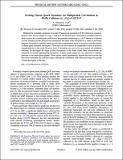Por favor, use este identificador para citar o enlazar a este item:
http://hdl.handle.net/10261/305311COMPARTIR / EXPORTAR:
 SHARE SHARE
 CORE
BASE CORE
BASE
|
|
| Visualizar otros formatos: MARC | Dublin Core | RDF | ORE | MODS | METS | DIDL | DATACITE | |

| Título: | Probing charm quark dynamics via multiparticle correlations in Pb-Pb collisions at √sNN=5.02 TeV |
Autor: | CMS Collaboration; Brochero Cifuentes, J. A. CSIC ORCID; Cabrillo, I. J. CSIC ORCID ; Calderon, Alicia ; Duarte Campderros, J. CSIC ORCID ; Fernández-García, Marcos CSIC ORCID ; Fernandez Madrazo, C. CSIC ORCID; Fernández Manteca, P. J. CSIC ORCID; García Alonso, A. CSIC ORCID; Gómez, Gervasio CSIC ORCID ; Martínez-Rivero, Celso CSIC ORCID ; Martínez Ruiz del Arbol, P. CSIC ORCID; Matorras, Francisco CSIC ORCID ; Matorras-Cuevas, Pablo CSIC ORCID; Piedra, Jonatan CSIC ORCID ; Prieels, C. CSIC; Rodrigo, Teresa CSIC ORCID ; Ruiz Jimeno, Alberto CSIC ORCID ; Scodellaro, Luca CSIC ORCID ; Vila, Iván CSIC ORCID; Vizán, J. CSIC ORCID | Fecha de publicación: | 2022 | Editor: | American Physical Society | Citación: | Physical Review Letters 129(2): 022001 (2022) | Resumen: | Multiparticle azimuthal correlations of prompt D0 mesons are measured in Pb-Pb collisions at a nucleon-nucleon center-of-mass energy of √sNN=5.02 TeV . For the first time, a four-particle cumulant method is used to extract the second Fourier coefficient of the azimuthal distribution (v2) of D0 mesons as a function of event centrality and the D0 transverse momentum. The ratios of the four-particle v2 values to previously measured two-particle cumulant results provide direct experimental access to event-by-event fluctuations of charm quark azimuthal anisotropies. These ratios are also found to be comparable to those of inclusive charged particles in the event. However, hints of deviations are seen in the most central and peripheral collisions. To investigate the origin of flow fluctuations in the charm sector, these measurements are compared to a model implementing fluctuations of charm quark energy loss via collisional or radiative processes in the quark-gluon plasma. These models cannot quantitatively describe the data over the full transverse momentum and centrality ranges, although the calculations with collisional energy loss provide a better description of the data. | Descripción: | CMS collaboration: et al. | Versión del editor: | https://doi.org/10.1103/PhysRevLett.129.022001 | URI: | http://hdl.handle.net/10261/305311 | DOI: | 10.1103/PhysRevLett.129.022001 | E-ISSN: | 1079-7114 |
| Aparece en las colecciones: | (IFCA) Artículos |
Ficheros en este ítem:
| Fichero | Descripción | Tamaño | Formato | |
|---|---|---|---|---|
| Probing-Charm-Quark-Dynamics-via-Multiparticle-Correlations-in-PbPb-Collisions-at-sNN-502-TeVPhysical-Review-Letters.pdf | 494,18 kB | Adobe PDF |  Visualizar/Abrir |
CORE Recommender
SCOPUSTM
Citations
6
checked on 09-abr-2024
WEB OF SCIENCETM
Citations
4
checked on 29-feb-2024
Page view(s)
21
checked on 17-abr-2024
Download(s)
7
checked on 17-abr-2024
Google ScholarTM
Check
Altmetric
Altmetric
Este item está licenciado bajo una Licencia Creative Commons

